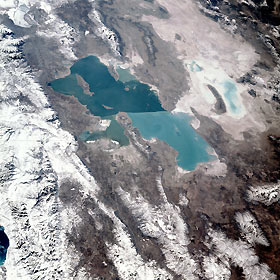
Save this image free of charge
in 800 pixels for layout use
(right click, Save as...)
|
|
Ref : T01290
Theme :
Looking at Earth - Desert - Dunes (200 images)
Title : Great Salt Lake, Utah, U.S.A. February 1990
Caption :
The turquoise Great Salt Lake of northern Utah, the largest salt lake in North America, is shown in this south-southwest-looking, low-oblique photograph. Winter snows cover the north-south trending Wasatch Range (located east of the lake) and smaller ranges scattered throughout the view. The western half of Bear Lake on the Utah-Idaho border can be seen northeast of the Great Salt Lake. The lake, 83 miles (134 kilometers) long and nearly 51 miles (82 kilometers) wide, is divided by a railroad bed (visible near the center of the lake) that traverses the lake east-west near its center. The railroad bed restricts the flow of water from one part of the lake to the other. The difference in colors (dark blue south of the railroad, turquoise north of the railroad) is due to differences in depth and salinity. The average depth of the northern portion of the lake is 13 feet (4 meters), but depths can reach 35 feet (11 meters) in the southern portion of the lake. The lake is fed by three rivers coming from the Wasatch Range to the east (not all visible in photograph), but it has no outlet. The Great Salt Lake varies in size and depth from year to year depending on rainfall. Above-normal precipitation has caused standing water or ponds to appear (visible in the photograph) in the Great Salt Desert west of the lake. The desert was part of prehistoric Lake Bonneville, which was over 1000 feet (300 meters) deep and covered an extensive area of the Great Basin of western Utah and eastern Nevada.
|
|

